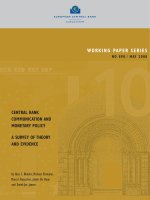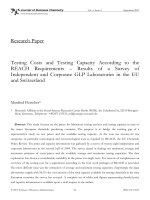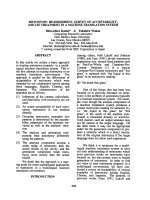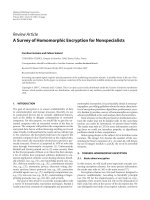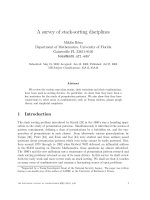A survey of factors that demotivate first-year non-major students in learning English at University of Labor and Social Affairs
Bạn đang xem bản rút gọn của tài liệu. Xem và tải ngay bản đầy đủ của tài liệu tại đây (1.19 MB, 67 trang )
VIETNAM NATIONAL UNIVERSITY, HANOI
UNIVERSITY OF LANGUAGES AND INTERNATIONAL STUDIES
POST-GRADUATE DEPARTMENT
NGUYỄN THỊ THU THỦY
A SURVEY OF FACTORS THAT DEMOTIVATE FIRST YEAR NON-
MAJOR STUDENTS IN LEARNING ENGLISH AT UNIVERSITY OF
LABOR AND SOCIAL AFFAIRS
(KHẢO SÁT CÁC YẾU TỐ GÂY GIẢM HỨNG THÚ HỌC TIẾNG ANH
CỦA SINH VIÊN KHÔNG CHUYÊN NĂM NHẤT TRƯỜNG ĐẠI HỌC
LAO ĐỘNG – XÃ HỘI)
M.A MINOR PROGRAMME THESIS
Field: English Teaching Methodology
Code: 6014.0111
Supervisor: Dr. Nguyễn Đức Hoạt
Hanoi, 2013
VIETNAM NATIONAL UNIVERSITY, HANOI
UNIVERSITY OF LANGUAGES AND INTERNATIONAL STUDIES
POST-GRADUATE DEPARTMENT
NGUYỄN THỊ THU THỦY
A SURVEY OF FACTORS THAT DEMOTIVATE FIRST YEAR NON-
MAJOR STUDENTS IN LEARNING ENGLISH AT UNIVERSITY OF
LABOR AND SOCIAL AFFAIRS
(KHẢO SÁT CÁC YẾU TỐ GÂY GIẢM HỨNG THÚ HỌC TIẾNG ANH
CỦA SINH VIÊN KHÔNG CHUYÊN NĂM NHẤT TRƯỜNG ĐẠI HỌC
LAO ĐỘNG – XÃ HỘI)
M.A MINOR PROGRAMME THESIS
Field: English Teaching Methodology
Code: 6014.0111
Hanoi, 2013
i
DECLARATION
I, hereby, certify the thesis entitled “A Survey of Factors that Demotivate
First-Year Non-Major Students in Learning English at University of Labor and
Social Affairs” is the result of my own research for the Minor Degree of Master of
Arts at University of Languages and International Studies, Vietnam National
University, Hanoi, and that this thesis has not, wholly or partially, been submitted
for any degree at any other universities or institutions.
Author’s signature
Nguyễn Thị Thu Thủy
ii
ACKNOWLEDGEMENTS
I would like to express my gratitude to all those who gave me the possibility
to complete this thesis.
First of all, I wish to send my sincere thanks to my supervisor, Dr. Nguyen
Duc Hoat, for his valuable guidance, helpful suggestions and critical feedback
throughout my research.
Also, I would like to acknowledge my gratitude to the staff members in the
Faculty of Post-graduate Studies for their useful lessons from which I have
benefited a lot for the accomplishment of this study.
I am greatly indebted to my students and my colleagues at University of
Labor and Social Affairs for their participation and assistance without which this
study could not have been successful.
Last but not least, I would like to express my special thanks to my loving
parents, my love, my dear sister and my close friends who offered me their love, care,
support and encouragement so that I could accomplish my study.
iii
ABSTRACT
This study aims to investigate the factors that demotivate the first – year non-
major students in learning English at the University of Labor and Social Affairs
(ULSA). In this study, 140 first-year non-major students from different faculties of
ULSA were chosen as the subjects. A questionnaire and an interview were used as
the data collection instruments. The findings of the study showed that the factors
demotivating students in learning English derive from 3 sources: students, learning
conditions and teachers. In details, among the factors, students’ lack of basic
knowledge and lack of confidence were the most demotivating then followed by the
class atmosphere, inadequate facilities, big size class and the teacher’s lack of
commitment. Based on the findings of the study, some discussion and implications
were made along with recommended suggestions for further research.At last, it is
hoped that the results of this study could be of much benefit for developing teaching
and learning English at University of Labor and Social Affairs.
iv
TABLE OF CONTENTS
DECLARATION i
ACKNOWLEDGEMENTS ii
ABSTRACT iii
TABLE OF CONTENTS iv
LIST OF ABBREVIATIONS vi
LIST OF TABLES vii
LIST OF FIGURES vii
PART A: INTRODUCTION 1
1. Rationale 1
2. Aims of the study 2
3. Research Questions 2
4. Scope of the study 2
5. Methods 2
6. Organization of the study 3
PART B: DEVELOPMENT 4
CHAPTER 1: LITERATURE REVIEW 4
1.1. Motivation 4
1.1.1. Definition of motivation 4
1.1.2. The importance of motivation in foreign or second language learning 5
1.2. Demotivation 7
1.2.1. Definition of demotivation 7
1.2.2. Factors that demotivate students in learning 9
1.2.2.1. Teacher-related factors 10
1.2.2.2. Learner-related factors 12
1.2.2.3. Learning conditions 14
v
1.3. Previous studies in the world and in Vietnam 15
1.4. Demotivation and English learning at ULSA 18
CHAPTER 2: METHODOLOGY 21
2.1. Participants and setting of the study 21
2.1.1. Participants 21
2.1.2. Setting of the study 22
2.2. Data collection 23
2.2.1. Data collection instruments 23
2.2.2. Data collection procedures 25
CHAPTER 3: FINDINGS AND DISCUSSIONS 26
3.1. Findings 26
3.1.1. Factors that demotivating students to learn English at ULSA 26
3.1.1.1. Student-related factors 26
3.1.1.2. Teacher-related factors 30
3.1.1.3. Learning conditions 32
3.1.2. The comparison among factors demotivating students in learning
English 34
3.2. Discussions 34
PART C. CONCLUSION 40
1. Conclusions 40
2. Pedagogical implications 40
3. Limitations of the study and suggestions for further research 41
REFERENCES 42
APPENDICES
vi
LIST OF ABBREVIATIONS
ULSA: University of Labor and Social Affairs
vii
LIST OF TABLES
Table 3.1: Students’ opinions on student-related factors
Table 3.2: Students’ opinions on teacher-related factors
Table 3.3: Students’ opinions on factors related to learning conditions
Table 3.4: Comparison among factors
LIST OF FIGURES
Figure 3.1: Students’ opinions on Student-related factors.
Figure 3.2: Students’ opinions on teacher-related factors
Figure 3.3: Students’ opinions on factors related to learning conditions
Figure 3.4: Comparison among 3 groups of factors
Figure 3.5: Comparison among factors
1
PART A: INTRODUCTION
1. Rationale
English has been more and more important in Vietnam in recent decades.
The number of people using it and the purposes they use it for are increasing.
English is now widely known as the main language of intercommunication,
international commerce and business, science and technology ect. besides the native
language used. Thus, people with good English competence are needed in any
fields, consequently, these people may have more opportunities to develop
themselves such as have a good job, earn more money, widen knowledge and have
a better life. As a result, there has been a positive trend of teaching and learning
English across Vietnam. Both children and adults learn English with different
purposes. Children learn it as compulsory subject at schools and their parents want
that. Students learn English to pass the exams, to study aboard or to find a good job
in the future. Adults learn English in order to communicate with foreigner, do
business or just to relax with English music, films and newspapers and books. In
general, despite deriving from different purposes, everyone wants to turn English to
become their own instrument in their lives.
As an English teacher, students’ proficiency and interests in learning English
are things that get lots of the teacher’s care and time. Truly, we, teachers, really
want to have an effective and interesting lesson each day. And it is clear that
students also hope and like to learn in those lessons like that. However, teachers
often say that they can easily recognize students who do things not relevant to the
lesson or do not pay attention to the lessons, some even say that because they do not
like English. As an English teacher, I am always thinking about this and really want
to find the solutions for eliminating factors that demotivate students’ motivation in
learning English because the researchers on motivation and demotivation have
pointed out that “the strongest influence on motivation was not the presence of
motivators in the classroom, but the absence of demotivators” (Christophel
&Gorham, 1995). At the beginning of the semester, the absence of context
2
demotivators and the absence of teacher behavior demotivators positively affect
motivation. This is true for both children and adults.
This is the reason why I choose studying on factors demotivating students in
learning English is the topic for my minor thesis. This study will examine main
types of demotivating factors that students meet. It also investigates the ways
students want their teachers do to help them overcome demotivation and it suggests
activities and techniques that help both teachers and students increase motivation in
learning English. The researcher hopes that this study will figure out a concrete
picture of demotivation in learning English of first-year non- major students at
University of Labor and Social Affairs (ULSA) and it will be of help for teachers
who want to increase students’ motivation in English learning.
2. Aims of the study
This survey is conducted in order to investigate demotivating factors to the
first year non-major students’ English learning at ULSA. The researcher would
expect to reveal the main factors that demotivate students in learning based on the
result of research, this study will propose some solutions that can help students
overcome demotivation as well as enhance motivation in learning English.
3. Research Questions
In order to reach the research aims, the researcher attempted to answer the
following questions:
1. What factors demotivate students in learning English?
2. What factors most frequently demotivate them in learning English?
4. Scope of the study
There are various factors affecting students’ learning English. However, as the title
of the study, the present research only focuses on exploring the demotivating factors
at ULSA. The reasons why the 1
st
year students chosen as the subjects of the study
will be further discussed in the following chapter.
5. Methods
This study which is both quantitative and qualitative consists of two
instruments to collect the data Firstly, the survey questionnaire was conducted
3
with 140 students from 4 classes of four faculties at ULSA, 35 students in each
class would be choose according to their even numbers in the name list. Secondly,
semi-structured interview with 20 students, who have done the questionnaire, were
carried out.
6. Organization of the study
This survey-designed study consists of three parts.
Part A deals with the introduction. This chapter provides the rationale, aims,
research questions, scope, methods, and design of the study.
Part B presents the development, which includes three chapters.
Chapter 1 deals with theoretical background and academic viewpoints on
definition of motivation, the role of motivation, definition of demotivation, and
factors that demotivate students in learning and demotivation in learning English,
some previous studies related and the case of ULSA.
Chapter 2 describes methodology. This chapter is composed of description
of methodology of the study, participants and setting of the study, data collection
instruments, data collection procedure, and data analysis procedure.
Chapter 3 presents data analysis and discussion. This chapter analyses,
discusses the results achieved from the study and offers some implications of the study.
Part C is the conclusion that presents the author’s reflection and the
outcomes of the study as well as indicates some limitations of the study and finally
gives some suggestions for further research.
4
PART B: DEVELOPMENT
CHAPTER 1: LITERATURE REVIEW
In this part, the author would like to give short review of motivation, the
importance of motivation in language learning, demotivation, demotivating factors,
previous studies and demotivation and ULSA.
1.1. Motivation
Among various factors that affect teaching and learning a foreign language
process of the learners, motivation plays an important role in learning process which
is thought to be a crucial reason for different achievement. As Scheidecker and
Freeman (1999:116, quoted in Dornyei (2001)) strongly stated that “Motivation is,
without question, the most complex and challenging issue today”. Therefore,
motivation has widely been studied and researched by teachers and researchers as a
determinant factor to success or failure in second/ foreign language learning.
1.1.1. Definition of motivation
Although motivation has been discussed widely among the teachers and
researchers, there are various definitions for motivation.
The current spirit in motivational psychology is characterized by cognitive
approach in which individual’s behavior is influenced by one’s conscious attitudes,
thoughts, beliefs and interpretation of things or in other words, how mental
processes are transformed into action. (Dornyei, 2001). In his view, the way people
do something, which is first determined by their beliefs about the value of what they
do and then how to face with challenge together with the support they get from
around, i.e. people or environmental working – is motivation. “[Motivation] is an
abstract, hypothetical concept that we use to explain why people think and behave
as they do” (Dornyei, 2001). However, this opinion is not fulfilled because in some
cases, there is no motivation. Later, his definition was clearer when he suggested
three dimensions responsible for motivation: “the choice of particular action”, “the
effort expended on it” and “the persistence with it”
5
One popular definition for motivation proposed by Gardner in his study of
social psychology and second language learning (1985), which regards motivation
as “the combination of effort plus desire to achieve the goal of learning the
language plus favorable attitude toward learning the language”. In his view,
motivation is the combination of effort, desire and favorable attitude that belong to
the interior dimension of learners. It is detectable that he neglected other aspects of
motivation such as learners’ stimulation linked to parents, schools, finance, peers,
and contents for instance.
Dornyei and Otto (1988) concluded that motivation is a “dynamically
changing cumulative arousal in a person that initiate, directs, coordinates, amplifies,
terminates, and evaluates the cognitive and motor processes whereby initial wishes
and desires are selected, prioritized, operationalised and (successfully or
unsuccessfully) acted out”. In their view, motivation is a complex phenomenon of
arousal which can change when a person works out and is an influential factor
throughout an action or a process.
In short, motivation seems to be considered a highly complex issue which is
easier to describe than to define. Different researchers have different ways of
defining motivation since they study motivation in different contexts: different
languages, with different subjects and different teaching -learning conditions. In this
study, the researcher understand motivation under three important factors of
motivation found by prior researchers: (1) the determination to the goal of learning
a language, (2) the effort to achieve that goal, (3) the maintenance of that goal or
effort and one thing should be remember about motivation is that it is not stable all
the time, motivation can change or be changed, increase or decrease over periods.
1.1.2. The importance of motivation in foreign or second language learning
Many researchers have shown that motivation plays an important role in
determining the result of foreign/ second language learning process. According to
Brown (2007), “motivation is one of the most important factors that will influence
students’ English achievement or performance. It has a close relationship with
students’ success or failure in English teaching in college. Therefore teacher must
6
pay more attention to this aspect”. Motivated students are likely to learn more and
learn more quickly than students who are less motivated. They also participate
willingly, actively and pay more attention to a certain learning task or activity and
gain more success and high marks.
Gardner (1985) stated that positive attitude and motivation are related to
success in learning a second/ foreign language. A highly motivated individual will
want to learn the language, enjoy learning the language, and strive to learn the
language.
According to Naiman et al (1978), the most successful students display
certain typical characteristics which are clearly associated with motivation as
follow. Students really want to solve the tasks and challenges, and they are
confident in their success. They think that success in learning is important to display
their own self-imagine. They have a need to attain and overcome difficulties and get
the goals that they set out to do before. These students go for demanding challenges
and top grades, high proficiency. They are aware of the goals of learning and direct
them to get them. They consistently spend high level of effort in learning and are
not encouraged by setback or apparent lack of progress. They are not disturbed or
frustrated by situations involving a temporary lack of understanding or confusion.
They are patient to be confident that understanding will come later.
All researchers agreed that motivation is a determinant to learning success.
Motivation helps to form good habits of learning (pay more attention,), right behavior
(aware of the goals, want to attain language, go for demanding challenges) and all
successful students show motivation as evidence contributing to their success.
Moreover, motivation not only has positive effects on motivated students but
also influence others’ motivation. It can be spread among students. Motivated
students can be sources to engage or stimulate others to learn when they interact or
work in groups during tasks or activities because in the light of psychology people
tend to be affected unconsciously.
7
In short, it is clearly that motivation is the essence of language learning
because it affects directly to students’ behaviors, habits, and it determines the
success or failure in foreign language learning.
1.2. Demotivation
1.2.1. Definition of demotivation
Demotivation is a relatively new issue in the field of second/foreign language
learning. Christophel and Gorham (1995) believed that “the strongest influence on
motivation was not the presence of motivativators in the classroom, but the absence of
demotivators”. It has been regarded as “another side of motivation”(e.g. Dornyei &
Ushioda, 2011; Falout & Maruyama, 2004; Sakai & Kikuchi, 2009) or in other words,
the negative of motivation which “has a negative impact on students, preventing them
from gaining expected learning outcomes” (Trang & Baldauf, 2007).
According to Oxford Advance dictionary, “demotivate” means “to make
somebody feel that it is not worth making an effort”. Because there is something
that raises meaninglessness or worthlessness in their mind when doing anything,
they do not want to pursue the task as well as try to perform it without any effort.
According to Zhang (2007), demotivation can be defined as “the force that
decrease students’ energy to learn and/or the absence of the force that stimulates
students to learn”.
According to Dorneyi (2001), demotivation refers to “external forces that
reduce or diminish the motivational basis of a behavioral intention or an ongoing
action”. However, not all the researchers agreed with this definition. Sakai and
Kikuchi (2009) stated that “Dorneyi limited the original definition of demotivation
to only external factors” and they also pointed out that in fact, Dorneyi (2001)
himself considered self-confident reduction and negative attitude as demotivating
factors in learning process. Then they felt the need to expand Dorneyi’s definition
of demotivation, concluding both external and internal factors which reduce or
diminish motivation during the process of learning. The loss of interest can
originate from many sources of demotivation, such as a teacher who cannot control
8
the class or a boring text book can be a demotive for learners or learners feel
demotivated because of experiences of failure.
Moreover, as mentioned above, motivation consists of 2 types: intrinsic and
extrinsic, for example, someone learns English intrinsically because he/she finds a
sense of pleasure when doing a task whereas extrinsically motivated learners learn
English due to the rewards, high marks or job promotion. These two types can be
independent or relevant to each other in contributing to learners’ motivation. For
example, extrinsic motivation can change into intrinsic when rewards of learning
English enhance learners’ confidence and love to the language.
From the sources of motivation, researchers agree that motivation can be
affected internally (inside the learners) or externally (outside the learners). Thus, the
other side of motivation, demotivation, also refers to both internal and external
forces which decrease interest and motivation in language learning process.
Demotivation is different from the total loss of learner’s motivation. According to
Dorneyi (2001), amotivation refers to lack of motivation resulting from realizing
that there is no point. Amotivation was introduced by Deci and Ryan (1985) as a
constituent of their self-determination theory and they (1985, as explained by
Dornyei 2001a: 144) define it as “the relative absence of motivation that is not
caused by a lack of initial interest but rather by the individual’s experiencing
feelings of incompetence and helplessness when faced with the activity”.
In fact, the positive influences that come from motivational basis can still be
there and positive motives may still be active in a learners’ learning process
together with negative influences. However, through time, demotivation can
develop into amotivation (Dornyei, 2001), that is, gradually demotivating
experiences can lead to the total loss of motivation, i.e. amotivation. Dornyei and
Ushioda (2011) have argured that “Some demotives can lead to general amotivation
regarding the particular activity (e.g. a series of horrendous classroom experiences
can reduce the learner’s self-efficacy)”
9
In this study, demotivation is understood as a process of reducing or
diminishing learners’ interest and motivation which concerns both external and
internal factors.
1.2.2. Factors that demotivate students in learning
Because of its strong impacts in learning, researchers have tried to
investigate factors that demotivate students to learn. The studies discussed in the
following illustrate that demotivation is a matter of concern worldwilde.
According to Chambers (1993), the underlying causes of student
demotivation perceived were quite different by the teachers and the students. While
teachers perceived them to be related to psychological, attitudinal, social, historical
and geographical reasons. The students perceived the causes of demotivation were
various, i.e, teacher’ behaviours, class size, ect. However, Chambers did not try to
determine what demotivating factors were or to look at them critically, he just listed
the students’ points of view.
Oxford (1998) conducted a qualitative study on demotivation, which focused
on a teacher’s influence on both motivation and demotivation. The finding from her
study revealed four broads sources of demotivation:
1. The teacher’s personal relationship with students
2. The teacher’s attitude towards the course and materials
3. Style conflicts between teachers and students
4. The nature of classroom activities.
In his study, the prompts specifically referred to the teacher’s responsibility
as a source of demotivation, participants in the study might not provide other
potential sources.
According Dornyei’s study (originally in 1998 but based on 2001), there are
9 categories of factors that demotivate students in foreign language learning as
follows:
1. The teacher
2. Inadequate school facilities
3. Reduction of self-confidence due to the experience of failure or success
10
4. Negative attitude toward the foreign language study
5. Compulsory nature of the foreign language study
6. Interference of another foreign language that pupils are studying
7. Negative attitude toward the community of the foreign language spoken
8. Attitude of group members
9. Coursebooks
Among 9 factors, the teacher factor ranks first. Teachers’ personality,
commitment to teaching, attention paid to the student, competence, teaching method,
style and rapport with students can have a direct impact on students demotivation.
Students also blame teachers’ indirect negative influence such as rigid classroom
management for their lack of confidence. Therefore, it is important to analyze the
teacher factors on order to ascertain possible solution to demotivation.
Based on the theoretical basis mentioned above, factors demotivating
students in foreign language learning can be classified into 3 large groups: teacher-
related factors, learner-related factors, teaching and learning conditions.
1.2.2.1. Teacher-related factors
According to Dornyei (2001), demotivating factors related to teacher sources
consist of teachers’ personalities, commitment, competence and teaching methods.
Teacher’s personalities
“The personality is the totality of character and behavioral traits to an
individual. No two persons are alike in this respect, not even identical twins”
(Cruickshank, Jenkins, and Metcalf, 2003) .Teachers with a good personality
promote students’ motivation. In fact, many students are excited, passionate and fun
to learn with a teacher because of the personality of the teacher is good and
interesting. But on the contrary there are also some students who feel discouraged,
demotivated, lazy, indifferent, sleepy and noisy because the teacher’s personality is
not good and not interesting. Thus, teacher’s negative attitudes have a strong impact
on students’ motivation. Teacher’s love and caring seem to be the most important
characteristics for a teacher to exhibit. Hunsaker (1988) claimed that “the main
11
value of humor in the classroom lies in its use to stimulate, illustrate, motivate and
ease tensions”. In Weaver and Cotrell’s study (1987), one student said “it’s not so
much sense of humor; they need to show students that they are human”. Weaver and
Cotrell (1987) established 10 steps for teachers to become more comfortable and
humorous in the classroom:
1. Smile/ Be lighthearted
2. Be spontaneous/ natural (Relax control a little/ break the routine
occasionally; Be willing to laugh at yourself/ don’t take yourself so seriously)
3. Foster an informal climate/ be conversational and loose
4. Begin class with a thought for the day, a poem, a short anecdote, or a
humorous example
5. Use stories and experiences that emerge from the subject matter. Use
personal experiences.
6. Relate things to the everyday life of students.
7. Plan lectures/ presentations in short segments with humor injected. Plan a
commercial break. Use a slide or overhead.
8. Encourage a give-and-take climate between yourself and students. Play off
their comments. Learn their names
9. Ask students to supply you with some of their jokes, stories, or anecdotes.
Share these.
10. Tell a joke or two. Do outrageous things. Admit you are no good at it.
Appear human.
• Teacher’s commitment to the students’ progress
Besides, teachers’ commitment strongly affects to students’ motivation as many
researchers have believed that the teacher’s commitment is the significant predictor of
student effectiveness. This is based on arguments claiming that student achievement is
intertwined with teacher’s commitment to their works, their school and their students
(Firestone and Rosenblum, 1988). According to Dorneyi (2001), teachers should show
commitment towards their students’ learning and progress, at the same time they
12
should care for what their students have learnt and succeeded. For example, teachers
should offer concrete assistance; offer to meet students individually to explain things;
or allow students to call at home when they have a problem.
Teacher’s competence
Many researchers have agreed that the most demotivating factor is teacher’s
incompetence, which can be defined as a cluster of behavior that reflect teachers’
indifference to the students and/or the course such as confusing and/or boring
lectures, unfair testing and information overload. A few studies by Fergusson
(1991) and Thomas (1989) also concluded that teacher’s qualification, i.e.
knowledge, education and experience account for a large share of the variance in
students’ achievement than any single factor. Medley (1982) stated that teacher’s
competency such as behavior, skills and knowledge related to school performance.
Effective teachers are those with high competency in knowledge and skills. In
addition, teaching a language that means introduce the culture of that language. If
the teacher lacks knowledge of speaking countries, his or her lessons are less
interesting to students.
Teaching methods
Teaching methods consisting of the teacher’s techniques and activities are of
great impact on learners’ motivation. Without good techniques and interesting
activities, learners may be left in confusion and boredom while dealing with
learning tasks. Therefore, teacher should invest more effort and thoughts in the
materials, the ways, and the time to use techniques and activities carefully for a
specific stage of teaching and assessing the learning performance. Arikal et al
(2008) claimed that effective teachers should have a student-centered classroom,
should be creative and should teach outside the syllabus.
1.2.2.2. Learner-related factors
There are various factors demotivating students in second or foreign
language learning, however these following factors are inferred to be the most
determinant. .
13
• Learner’s lack of basic knowledge of English
Among the factors, the first and most important factor is their basic knowledge.
Background knowledge refers to the existing information on a specific topic in each
language lesson. Therefore, if students lack background knowledge, it is difficult for
them to get involved in learning activities. They will be unable to comprehend new
materials and more importantly, they will lose their interest in learning lessons.
Realizing the influence of this factor, the teacher needs to provide the amount of
background information available and to see that they are able to use them.
Besides, language items such as vocabulary and grammatical structures can
be considered to have an impact on the students’ feelings. This causes difficulties in
getting meaning as well as practicing language skills.
Learner’s prior knowledge is known to be an important prerequisite for
individual knowledge construction and learning outcome. Theoretical approaches
stress the importance of learner’s background knowledge when acquiring new
learning material (Weinert and Helmke, 1998). It can be implied that if the student
lacks of background knowledge, he can easily get demotivated because he must feel
more difficult in learning.
Learner’s personality
Through the learner’s personality varies from person to person, it is a key
factor that can motivate or demotivate the learner in learning foreign or second
language learning. Many researchers on demotivation of learners’ personalities have
been investigated. In addition, there is a close connection between a person’s
personality type and their learning style. If they find their own style is not suitable
to the context of learning, they will be demotivated.
Learner’s lack of confidence
Learner’s motivation can strongly decrease depending on how much
confidence learner’s lack. As a result, when a learner lacks confidence toward the
language they are learning and the environment they are in, they can easily get
14
anxiety which not only demotivate them but also is related to proficiency as
suggested by Clemen, Dorneyi and Noel (1994)
Learner’s belief
Most learners have strong believes about how languages are learnt, show their
instruction should be delivered. According to Lightbrown (1999), “These believes are
usually based on previous learning experiences and assumption (right or wrong) that a
particular type of instruction is the best way for them to learn”. Chamber’s study
(1993) showed that lack of belief in learners’ capability, laziness and unwilling to learn
are the main characteristics of the demotivated students in Britain.
1.2.2.3. Learning conditions
Researches has shown that learning conditions involving physical conditions
,the textbook used and class atmosphere can demotivate students in learning English.
Physical conditions
The physical conditions refer to the classroom size, chairs, desks, tables,
lights, temperature, and boards – such conditions had great influence on students’
learning as well as their attitude toward subject matter (Harmer, 1992). These
conditions therefore can demotivate students if they are not qualified. In Dorneyi’s
study (2001), students reported that in some class, beginners were turned out to be
known as students who already knew English and this had placed them with
advanced level students. This situation is the same as the researcher’s class.
Before becoming students at ULSA, all of them were asked to take the entrance
exam with different subjects at high school. These groups are A (consisting of
Math, Chemistry, Physics), A1 (Math, Physics English) C (Literature, History,
Geography) and D (English, Maths and Literature). Although at the beginning of
the course they were different at English levels they were put in the same class
and studied the same course books. This demotivates students at both higher and
lower levels. In addition, at ULSA the class size is often too big to study English,
often more than 60 to nearly 80 students in a class.
Classroom atmosphere
15
Other factors related to learning environment is a pleasant and supportive
atmosphere in the classroom as Lightbown and Spada (1999) claimed that
supportive and non-threatening atmosphere makes a contribution to learner’s
motivation. In other words, negative, stressed, unsafe and boring atmosphere
tremendously demotivate students in learning. For example, one student often felt
confused and unconfident because she felt that other groups laughed at her poor
English skills (Dorneyi’s study, 2001).
• The textbook
It is the fact that not every course book is interesting and attractive to
students. When students do not like the course book, they describe it “the worst
course book in the world” and “incredible bad” (Dorneyi, 2001). It is strange that
students feel motivated with the course book they hate.
1.3. Previous studies in the world and in Vietnam
Dorneyi’s study
Dorneyi’s study (originally in 1998 but based on 2001) was qualitative. The
Subjects consist of 50 pupils in various secondary schools in Budapest, Hungary who
were studying either German or English as a foreign language and they had been
considered as being particularly demotivated by their teachers or peers. He collected
the data by using structured interviews from 10 to 30 minutes. The subjects were asked
to answer a list of questions but they were allowed to speak freely.
From the data, nine categories of demotivating factors were the teacher, self-
confident reduction, inadequate school facilities, negative attitude toward L2, the
compulsory nature of the L2 learning, interference of another foreign language,
negative attitude toward the L2 community, attitude of group member and course book.
The teacher-related factors accounted more than half of all demotivating
factors. Two factors with significant proportions (more than 10%) were inadequate
school facilities and negative attitude toward the L2. The strength of Dorneyi’s
study laid in his focused approach to study demotivation. In detail, he focused
students who were identified as demotivated one, which offered details and
16
comprehensive insights into the sources of demotivation. However, the source of
demotivating factors might be wider if the study consists of students who are not
specifically demotivated because in fact, every leaner has some experience of being
demotivated at some time and different levels during the process of L2 learning.
Sakai and Kikuchi’s study
Sakai and Kikuchi (2009) investigated 6 factors from reviewing previous
studies of demotivation in learning, concluding teachers, characteristics of classes,
experiences of failure, class environment, class materials, and lack of interest. They
administrated a 35-item questionaired to 656 Japanese high school students and
identified the following sources of demotivation: 1) Learning contents and
materials, 2) Teachers’ competence and teaching style, 3) Inadequate school
facilities, 4) Lack of intrinsic motivation, and 5) Test scores. In contrast to both
previous studies, teacher-related factors were not the most demotivating factors, that
learning contents and materials and test scores are the prominent demotivating
factors for various students.
• Kikuchi’s study
Kikuchi (2011) conducted a research among 1334 Japanese senior high
school students at 7 high schools. The questionnaire was used as the data
instrument. The demotivation was found from these sources: students’ difficult
experience or loss of interest in leanring. In addition, influence from teachers also
causes demotivation and material focusing on difficult reading passage and/or
vocabulary causes the strongest sense of demotivation. Kikuchi’s study also reviews
on demotivation and demotivators of previous study in detail. The questionnaires he
used depend on analysis of other study and chose the most effective points such as
from Dornyei, Oxford and Gardner. His study is one part of the background for this
study. However, only questionnaire was used. If there were interviews with
students, the deeper information could be collected from students.
Trang & Baldauf’s study

